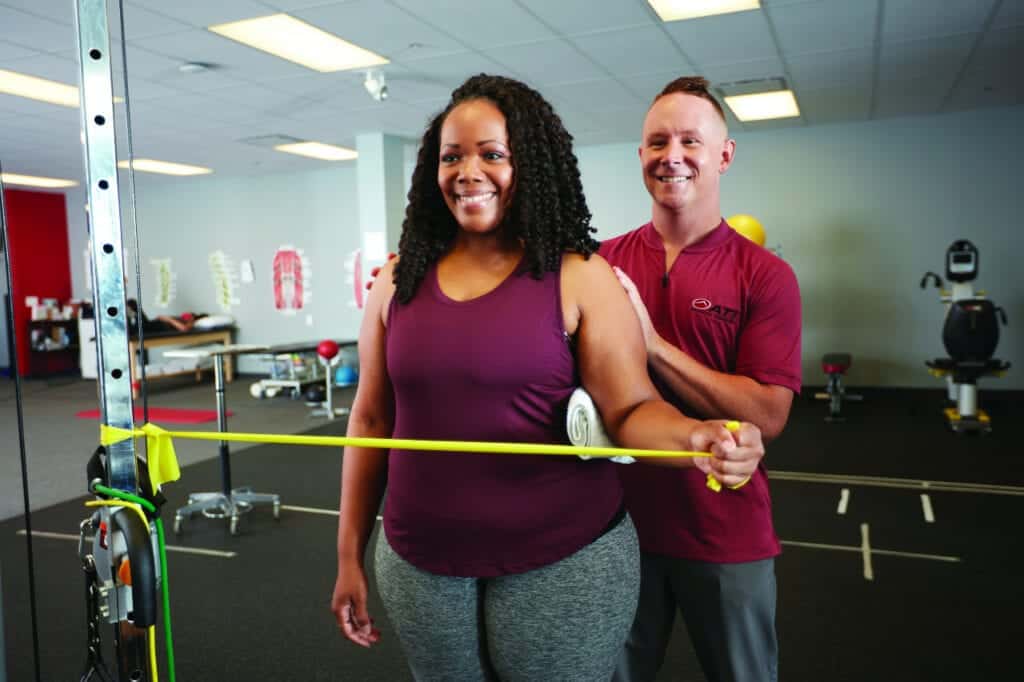PHOTO CAPTION: If a patient is expected to experience future lower back pain, the physical therapist should provide education about the importance of movement to help her or him avoid fear and further damage to the back.
Therapists can use an individual’s own beliefs and experiences to unlock effective pain treatment
by Mark Halley, PT, DPT, OCS, CFMM, TPS
As medical research makes strides into the evidence of pain science, overall, healthcare professionals have learned that pain is complex, multifactorial, and individual to each patient. As therapists treat patients with lower back pain, they see that everyone has fears and beliefs that play a role in their improvement. This article outlines the factors at play with lower back pain and explains how to encourage patients to resume previous activities and consider improvements in health to prevent reoccurrence of symptoms. It also offers insights that therapists can share with patients about treating themselves if lower back pain symptoms do occur.
Fear-Avoidant Beliefs
As clinicians, we naturally want to help patients to return to their normal activities. We also want to promote wellness that prevents an individual from becoming injured in the first place as well as the reoccurrence of symptoms. However, a patient’s own beliefs, understanding, and goals may act as a barrier therapists have to work through to restore the patient to health. As an example, chronic pain conditions oftentimes are spurred on through altered fear-avoidant beliefs and altered behaviors following injury. The Fear Avoidance Model explains that injury and personal pain experience can lead to catastrophizing and threatening illness information or beliefs—and fear-related avoidance. These reactions can lead to activity changes and hypervigilance to further current pain or lead to future pain experiences.1 Furthermore, activity changes or avoidance in some patients can lead to deconditioning or avoidant behavior. Eventually, this can lead to a future injury either related or unrelated to the initial condition.
The processing and development of reaction to injury is a normal part of the body’s pain system, as laid out in the mature organism model explained by Louis Gifford.2 The individual’s system is ready to take in, learn, and apply experience to new injuries to protect, react, and heal. However, there are times when the individual’s system can take on and overreact, which prevents them from engaging in future activities or forces them to avoid and change normal and healthy habits that lead to future health decline and deconditioning. This can explain the patient who is fearful and avoids lifting following a lower back strain. As clinicians, we know the patient is capable and likely will not have any further harm once their tissues heal. However, the patient believes they will cause further injury or reinjure themselves.
Screening Symptoms
It should be the therapist’s goal to understand patients’ fears and educate them about normal mechanics, typical healing timelines, pain processing, and resumption of previous activities. Furthermore, it is the therapist’s responsibility to screen and determine the source of the symptoms. From continued research into pain science, pain can have symptoms that arise specifically from the injured or overloaded tissue (muscle, joint, joint capsule, ligamentous, fascia, etc); from nerve irritation from injury or hypoxia due to reduced movement and inflammation; and from centrally mediated processing and hypersensitization. As therapists treat patients, these factors need to be taken into consideration.
One patient may have lower levels of fear, when more of their symptoms are related to soft tissue joint capsular strain and inflammation. Their course of treatment would be to instruct about stretching through the day to improve motion and educate about healing times of tissues; within the clinic, they are more independent to perform active movements and functional activities. This patient is typically easy—symptoms reduce over time, and the person resumes normal activities.
Another patient with acute lower back pain can present with high levels of pain, be very guarded or sensitive in the injured region, have some radicular signs, and be highly irritable. This patient, as his or her symptoms are teased apart, presents with the same mechanical symptoms, but may also have increased neural tension into the leg. Upon questioning, the patient is afraid to move the back and fears that surgery will be needed since the same thing happened to an uncle who never fully recovered after undergoing surgery. Now, this may make the therapist want to slowly back out of the room in hopes another therapist will take this case. However, this patient is also quite easy to manage once all the parts of the symptoms are considered. The bigger issue is the patient’s fear and beliefs, and these need to be addressed compassionately. This patient may need more understanding about his or her own pain and how the body has become more sensitive or hypervigilant due to extra processing from past experiences, knowledge, and beliefs. This high fear and avoidance and catastrophizing can prompt further unwanted symptoms or reactions over time and can lead to chronicity of symptoms as shown in the Fear Avoidance Model.
Managing the Patient
These are steps therapists can take to treat and manage the patient. One is to screen out fear-avoidance beliefs using objective questionnaires such as the Oswestry Low Back Pain Questionnaire or Fear Avoidance Beliefs Questionnaire. Clinicians can also ask questions about previous injury, patient goals, and thoughts about returning to normal activities and activities they would now avoid or lessen following the injury.
By giving patients the understanding that these injuries can occur, therapists can normalize their avoidance of movements that coincide with their mechanism of injury or current tissue irritability. Given that all major red flags of fracture, instability neurologic compromise are ruled out, resumption of normal movements is key in most orthopedic injuries.
While many modalities have not been found to be effective in the treatment of acute or subacute lower back pain, we should consider the patient’s own beliefs in their care. What does the patient believe can reduce their pain? This may make an argument that the use of heat, ice, or topical analgesics relaxes the patient before or following the progression of movement in the acute phase of treatment. And use of manual techniques, soft tissue mobilization, joint mobilization, manipulation, and muscle energy techniques from research shows no significant change in structure; however, it does provide input into the patient’s pain system. This input further provides pain modulatory effects and promotes movement. The use of therapeutic exercise further provides movement to the affected tissues/joints, improves vascular blood flow to reduce inflammation, and further provides sensory input to reduce guarding. All these things, when applied to the patient, depending upon their level of irritability and their beliefs and fears, can impact change in their healing process. The treatments used, along with providing the necessary rationale to educate the patient’s understanding of why you are suggesting the treatment, can reduce their fears and promote adherence to progression to normal activities, mitigating resultant chronicity.

Preventive Power
Prevention of subsequent reinjury falls onto the notion that our body has a normal capacity for activity. Through improvement of strengthening, cardiovascular conditioning, motor control practice, and flexibility, we can enhance our body’s capacity for activity, which will reduce overload and other injuries. This prevention can be easily taught to and become a motivating factor for patients who normally would not exercise or maintain a healthy lifestyle. In this motivation, any minor change—even 30 minutes of exercise or activity beyond their normal daily activities, going for a walk, or performing a short yoga program at home—can make an impact on future health.
When designing a home program, printing a laundry list of exercises will likely gather dust on a coffee table. Ask patients about activities they enjoy. Try to provide ideas about where to find video workouts, stretching routines, and exercises that fit their abilities and desires. If patients have a specific goal or interest, they would more than likely adhere to it.
Educating the Patient
Another point to make in improving a patient’s self-efficacy in reducing further symptoms and preventing injury is to promote changes in positioning through the workday. In addition to specific education about workstation ergonomics, the patient should be educated on the effects of prolonged positioning and the importance of movement throughout the day. Typical education can include changes in positioning every 30 minutes. For example, instruct the patient about standing for a minute, extension-type stretches following prolonged sitting, or flexion-based stretches following prolonged standing.
Improvement of the patient’s self-efficacy about his or her ability to reduce future symptoms and reduce current symptoms through active movement and education on their condition and health can reduce fear and future disability. It is important to give the patient some compassionate understanding that lower back pain or strains are a normal part of life and are not always a seriously debilitating condition. If the patient is expected to experience future lower back pain, educate that person about the importance of movement, light movement within a reasonable tolerance, use of heat or ice depending upon preference, and resumption of normal activities as symptoms reduce.
While this is not an exhaustive explanation of pain science and the multifactorial nature of pain and chronic pain, this should be seen as a stepping point to guide patients into a good direction within the acute or subacute phase of lower back pain or injury to prevent or reduce their likelihood of developing chronic pain conditions. As clinicians, it is always our best intention to help our patients. However, it is our responsibility to further understand pain mechanisms and interpret the differences between each patient. Once we discern a patient’s needs, we can treat that person based on his or her fears and beliefs and provide education about their ability to mitigate future episodes. RM
Mark Halley, PT, DPT, OCS, CFMM, TPS, Fellow of Pain Science, is an outpatient physical therapist at ATI Physical Therapy in Dundalk, Md. Halley graduated from the University of Maryland Baltimore in 2006. For more information, contact [email protected].
References
- Leeuw M, Goossens ME, Linton SJ, Crombez G, Boersma K, Vlaeyen JW. The fear-avoidance model of musculoskeletal pain: Current state of scientific evidence. J Behav Med. 2007;30:77-94.
- Thacker M. Louis Gifford – revolutionary: The Mature Organism Model, an embodied cognitive perspective of pain. In Touch. 2015;152:4-9.
Related Content:
Gene Therapy Offers Opioid-Free Chronic Pain Management Solution
New Pain Triggers, Thanks to the Pandemic
Treating Pain with Low vs High-Power Lasers: What is the Difference?



